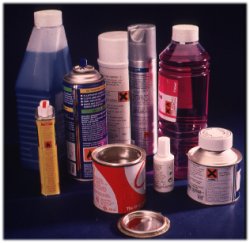Drugs Information and Drugs Factfile
Information on Drugs for everyone including parents - Solents and Inhalents
Drugs Information, what you really should know about, drugs facts on and facts about Solents and Inhalents
A Guide for worried parents, teenagers who are using drugs or thinking about using drugs and anyone who wants to know more about the subject.
This website has been accredited by the Matthew Project in Norwich, Greater Manchester Police force and the Office of National Drug Control Policy (The White House)
Solvents /
Inhalents
Inhalants refer to legal substances that are sniffed or
huffed to give the user an immediate head rush or high. Inhalent use can
cause a number of physical and emotional problems, and even one-time use can
result in death. Inhalants fall into three categories: volatile
solvents such as glue, gasoline, aerosols; anesthetics such as
nitrous oxide andnitrites such as amyl and butyl nitrite.
They consist mainly of aerosols, lighter fuel, glues, cleaning fluids, (gas)
chemical solvents, paints stripper, petrol, marker pen, deodorant, typewriter
correction fluid and dry cleaning fluids.
Solvent misuse is most common among youngsters aged from 12 to 16 although
younger children may experiment too.
Common Street Names: How they are taken: |

|
The risks:
Loss of control or unconsciousness, sometimes leading to serious accidents,
kidney damage, liver damage, heart failure. Can sometimes cause death by
choking on vomit or suffocation by freezing air passages. Death by toxic
attack on the heart. Young people die every week from solvent abuse in the
u.k. Over a third of deaths are first time users. Death can occur very
rapidly from heart failure as a result of sniffing any of these products.
Long term heavy use, particularly of glue, can damage the brain, liver and
kidneys. Regular use can also be habit forming and this can be difficult to
break.
There is an increased chance of accidents happening when sniffers are high on
solvents especially in a dangerous location like a train line, riverbanks,
high buildings or main roads.
Solvent use is not illegal, but it is illegal for a shop keeper to sell
solvents to anyone under 18 if they know they are intended for
abuse.
Effects
Inhalants act on the brain and destroy the outer lining of nerve cells,
making it impossible for those cells to communicate. Symptoms of use include
dilated pupils, blisters or rash around the nose or mouth, chronic cough,
nausea and headaches, disorientation, chemical odor on breath. After only six
months of use, the brain, lungs, nerves, liver, kidneys and bones may be
permanently damaged.
| Using inhalents even one time can put you at risk for: | |||
| sudden death | suffocation | visual hallucinations and severe mood swings | numbness and tingling of the hands and feet |
| Prolonged use can result in: | |||
| headache, muscle weakness, abdominal pain | decrease or loss of sense of smell | nausea and nose bleeds | hepatitis |
| violent behaviors | irregular heartbeat | liver, lung, and kidney impairmant | involuntary passing of urine and feces |
| irreversible brain damage | nervous system damage | dangerous chemical imbalances in the body | |
| Short-term effects: | |||
| heart palpitations | breathing difficulty | dizziness | headaches |
For information about other drugs, return to Drug Information Page.